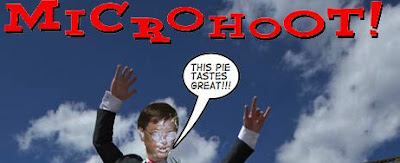Hacked Digital Billboards
Posted in: UncategorizedSomeone known as Skullphone has hacked into a few ClearChannel billboards in California to insert the trademark image.
— via Textually
Someone known as Skullphone has hacked into a few ClearChannel billboards in California to insert the trademark image.
— via Textually
For those of you who don’t know , Bodies: The Exhibition is an event created by german artist and scientist Gunther Von Hagens, where real human corpses preserved through the process of plastination are showcased to observe human anatomy at its core.
Yesterday I had the privilege of seeing this exhibition and even more, to see it with the lovely Paula, and without a doubt, this is a unique event.
With tours that go through each of the body systems, a disposition of the different body parts that allows thorough analysis of each, and assistance from young health related students; this exhibition is at first an obliged visit for anyone in the medicine field, but mostly it is an event that must be seen by anyone who wants to understand and be amazed by the wonder of the human body.
For further information visit Bodies’ official website.
English Russia has a collection of Ukrainian mobsters’ tombstones. Note how many of them have a depiction of a Mercedes — a symbol of a certain social status in the 90s. Do these tombstones reinforce a brand impression on a casual cemetery visitor? Do the impressions change after 5, 10 years?
Earlier:

Practice the Gettysburgh Address in PowerPoint format
Boston Globe: “If you’ve never heard of PowerPoint Karaoke, that probably means you’re neither German nor a hardcore techie. The phenomenon has been spreading geek to geek and conference to conference since it was invented by a German artists’ group in 2005.
In a typical event, a few brave people volunteer to “present” a random deck of slides pulled off the Web, or borrowed from friends or employers. The audience laughs, cheers, and yells out suggestions as the presenters gamely struggle to link one slide to the next, transforming something that probably started life as a tedious corporate monologue into a five-minute flight of creative irony.”
All too familiar: an overhyped and then abandoned media darling turns into a bloodthirsty monster. At least, Knut was cute.
Living in Boston, while not without its advantages, isolates you from some of the more interesting things happening elsewhere in the country.
Creation Science Fair, 2001, high school:
1st Place: “Using Prayer To Microevolve Latent Antibiotic Resistance In Bacteria”
“Eileen Hyde and Lynda Morgan (grades 10 & 11) did a project showing how the power of prayer can unlock the latent genes in bacteria, allowing them to microevolve antibiotic resistance. Escherichia coli bacteria cultured in agar filled petri dishes were subjected to the antibiotics tetracycline and chlorotetracycline. The bacteria cultures were divided into two groups, one group (A) received prayer while the other (B) didn’t. The prayer was as follows: “Dear Lord, please allow the bacteria in Group A to unlock the antibiotic-resistant genes that You saw fit to give them at the time of Creation. Amen.” The process was repeated for five generations, with the prayer being given at the start of each generation. In the end, Group A was significantly more resistant than Group B to both antibiotics.”
I put together a YouTube playlist with a compilation of 13 14 recruitment ads from different countries. Comparative military propaganda highlights of the weird:
The three Swedish spots are the best. Au Pair targets women and lures them with an opportunity to blow up bridges (when was the last time a Swedish soldier blew up a bridge?). Cube and Labyrinth are wacky but very stylish. Shows how the Swedish army values cognitive abilities over muscles.
British Army – shots of a party scene are there why? (another spot has a beach and women in bikini)
The Russian spot promises recruits that they finally will be able to afford to buy flowers and a night on the town for their girlfriends. Definitely not for external consumption. (The spot is for “kontraktniki”, the volunteer part of the army).
I can’t tell if the Ukranian spot isn’t a spoof. YouTube has a translated dialog script if you expand “About the video” part.
Other armies in the playlist are Pakistani, Indian, Canadian, American, Czech, Slovak, Australian, [update] and Estonia (thanks, Toivo).

“The New York Times in Russian. Tell Americans and the entire world about Russia.”
The New York Times has started an interesting project on LiveJournal (LJ), one of the first blogging platforms that was recently sold to a Russian company. The newspaper picks an article about Russia, translates it in Russian, posts it on a LJ, solicits comments, than translates the comments back to English and posts it under the original article. The newspaper’s editors moderating the site promised, “You’ll see that we are not afraid of critisism and willl post a large number of negative comments in our address.”
The first and so far the only article about the upcoming elections has attracted 1780 comments from mostly angry Russians. About 140 of the most civil were translated back. Here’s one of them: “I read the first paragraph [of the article] and it was enough. Sort out everything in your democracy first.”
Pink Tentacle: “Researchers at Kansai University have developed a machine that can scientifically measure the quantity of a person’s laughter, as well as distinguish between the real and the fake.
The sensors, which attach to a person’s cheeks, chest and abdomen, take 3,000 measurements per second. Sensor data is relayed to a computer, where it is analyzed by special software that determines the nature of the laugh and assigns a numerical score based on the quantity.”
Would be fun to measure the quality of the canned laughter on TV shows.
Quite a while ago, when my interest for digital art started turning obsesive, I realized that most of the artists that blew me away then (and still do today), had one thing in common: They all were part of the Keystone Design Union.
It was then that I set myself as a long term goal to one day be a part of this select group of artists and visionaries I admire so much. And today finally, it’s true. I’m finally a member of the group I so admire.
My deepest thanks to the good David Harris for all his assitance and answering my ever-growing amount of questions, and of course to the great David Gensler for recruiting me.
It’s an honor to share up-close with such talented people.
So from now on around here, you can also trust The KDU.
This is today’s front page of Boston Now, one of the city’s free commuter papers, but it looks almost like an ad for, what else, cheaper and stronger heroin.
Someone famous (Ogilvy?) said that it was a good idea to make a habit of picking up magazines that are outside of your usual set. The ones below would probably work.
“Each issue of American Cemetery offers in-depth coverage of issues affecting the cemetery profession in today’s competitive business environment, including grounds maintenance tips, national and state association coverage, preneed, marketing, cremation, insurance computers/software and much more.“
Onion World, because “onions are the third largest consumed fresh vegetable in the U.S.”
Plumbing Systems and Design is “the official publication of the American Society of Plumbing Engineers, is the magazine for plumbing engineers, designers, specifiers, code officials, contractors, manufacturers, master plumbers, and other plumbing professionals.”
Railway Age “leads, instructs, reports and commands a $20 billion industry to review your products and services. Penetrate the marketplace with Railway Age, the publication that has written the book on the railway industry since 1876.”
Supply & Demand Chain Executive is “the executive’s user manual for successful supply and demand chain transformation, utilizing hard-hitting analysis, viewpoints and unbiased case studies to steer executives and supply management professionals through the complicated, yet critical, world of supply and demand chain enablement to gain competitive advantage.” Now with podcasts.
Blogosphere hasn’t had that much fun since Google’s acquisition of YouTube that has enriched the vernacular with numerous linguistic gems ranging from GooTube to YouTooble.
Here’s what we have so far for the Microsoft-Yahoo deal:

AdLab’s favorite: Microhoot by Gizmodo
Seen on Infade (this one is back from May 2007)

Seen on Techcrunch

Seen on Ad-Supported Music

Seen on David Armano’s
Pictureless: YahooSoft (CNN), Yaasoft (FastForward blog), Yahrosoft. A CNet blog considers relative advantages of Yasoft, Mihoo, and Microhoo (Micro-who?), and even has a handy poll .

“The 1990 World Cup tops the list of record-breaking TV “pick-ups” (Source: National Grid, BBC)”
Even though the Superbowl Flush is a myth and our American readers have nothing to fear this coming Sunday, it doesn’t mean that the collective ad avoidance doesn’t strain urban infrastructure elsewhere. Virtual Economics unearthed a decade-old article from BBC about Brits leaving their TVs during the World Cup half-time to — what else? — make some tea:
“This mass synchronised tea-break has in the past caused huge power surges and problems for the National Grid, which operates the high-voltage transmission network in England and Wales.
A crack team of statisticians with their finger on the pulse of the TV sub-culture leaf through listings magazines in an attempt to predict peaks in electricity use.”
The great annual theater festival Santiago a Mil has been involved year after year in bringing to our humble country some of the most important and amazing performances worldwide, and this year it was no exception.
Today I had the privilege of seeing the beautiful “Players of Light” show, by the incredible Groupe F.
An outdoors and free event that involved everything I enjoy: Great music, mind-blowing fireworks, all sorts of lights and beautiful colors.
An experience that went on for a little over an hour that felt like ten minutesU, but I’m pretty sure it must have left the thousands of people that were there more than satisfied.
A sublime experience. A captivating game of lights of unmatchable quality.
Oobject has a list of objects and suppliers that you’ll need to remodel your house to look like an Apple store (via Make). Don’t forget to dress up like the Mac guy from the commercials.
Fast Company runs an article in which Duncan Watts, a network-theory scientist, puts to test the idea that trends are sparked by a handful of highly connected individuals, or the influentials, as they have become known after the bestsellers The Tipping Point and The Influentials.
“Watts believes […] a trend’s success depends not on the person who starts it, but on how susceptible the society is overall to the trend–not how persuasive the early adopter is, but whether everyone else is easily persuaded. And in fact, when Watts tweaked his model to increase everyone’s odds of being infected, the number of trends skyrocketed.
If society is ready to embrace a trend, almost anyone can start one–and if it isn’t, then almost no one can,” Watts concludes. To succeed with a new product, it’s less a matter of finding the perfect hipster to infect and more a matter of gauging the public’s mood. Sure, there’ll always be a first mover in a trend. But since she generally stumbles into that role by chance, she is, in Watts’s terminology, an ‘accidental Influential.'”
Watts has published several books on the subject, including Six Degrees: The Science of a Connected Age.
Update [Jan 27 ’08]: Mike Arauz from Deep Focus responds.
My own beef with the theory of influentials is its implicit assertion, in my understanding of The Tipping Point, that if you have influence over a certain social network, this influence will have the same weight over the entire range of topics. I don’t know if this Absolute Influence exists, and my own daily experiences offer nothing to support the idea: it is not a given that someone who is an apparel fashion trendsetter in one particular network will be have the same influence over the choice of others’ plasma TVs, for example. Likewise, one’s influence will also vary across different networks, which makes identifying and targeting The Influentials a much more complex task than it is suggested by the theory advocates.
I hadn’t realized I hadn’t posted anything about Helvetica: The Film, the movie about Helvetica, the typography.
I heard of it being made over a year ago, and since then I’ve been eagorly waiting to see it.
In the end the veredict is only one: It was worth the wait.
The documentary is excellent. Its editing is exceptional, the interviewed amazing, and the typography a modern classic.
From the testimonies of design geniuses such as Massimo Vignelli, Matthew Carter, David Carson, Paula Scher, Stefan Sagmeister and Eric Spiekermann among various others, Helvetica: The Film is a first class visual testimony that should without a doubt be seen by every graphic designer around the world. In fact I believe it should be being showcased in all design schools all over the globe. So if there happens to be any school directors passing by here, please try to show it. Your students will be grateful.
The best of all the documentary, in my opinion, is that it really manages to give Helvetica its well deserved protagonism, but at the same time gives an enormous amount of life advice, first to graphic designers, but really to any person who watches it.
This isn’t only a documentary about a typeface. It’s a graphic design guide written by the beautiful Helvetica.
And of course, not to leave you hanging. Here’s the full documentary.
From the mail that AdLab readers and PR people have sent in over the past couple of weeks:
Prudent People Brag: “According to a recent study conducted by the Mindset Media, people who report that they always pay their credit card balances in full each month, […] to be far less modest than the rest of the population at large — “Modesty 1’s,” who are, perhaps, unable to resist bragging about their highly responsible credit habits.
JunkieAd.com creator would like to let the world know about another blog collecting creative advertising.
USA Today’s Media Lounge accepts submissions from ad bloggers.
If I understand the terminology correctly, WebCollage.com lets downstream sales partners reuse the rich interactive functionality of the mothership site with less friction.
Spot Runner (one of the ad automation companies) has acquired GlobeShooter, a network of 1,200 independent filmmakers, videographers, producers and production companies across the U.S.
Flow automatically tracks the design process from idea to end result and manages assets and applications for the most complex workflows.
Hammerhead agency promotes itself with this video.
Luke Sullivan’s legendary “Mr.Whipple” guide to great ads is out in its second edition.
For dessert, some spam: “The NOKIA Electronic Email Promo,was established 1970 by the Multi-Million groups and now supported by the Economic Community for West African States (ECOWAS), United Nations Organization(UNO), United Kingdom(UK) and the European Union (EU) was conceived with the objective of human growth, educational, and community development.”